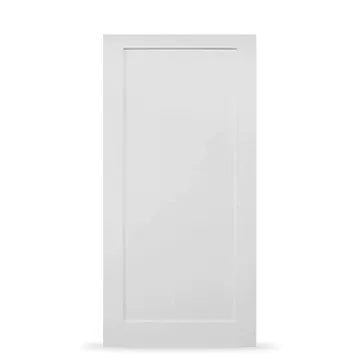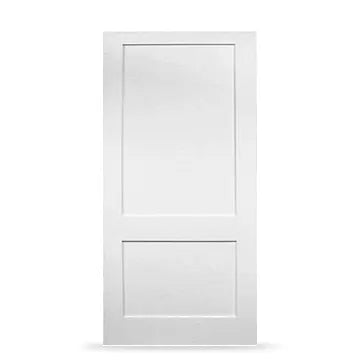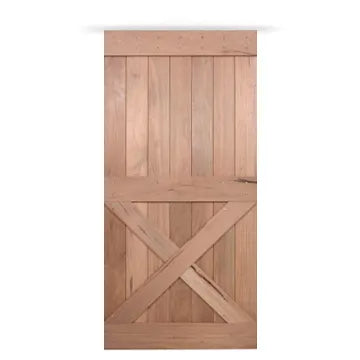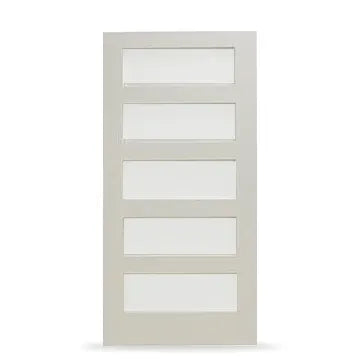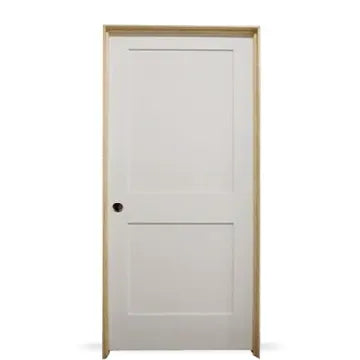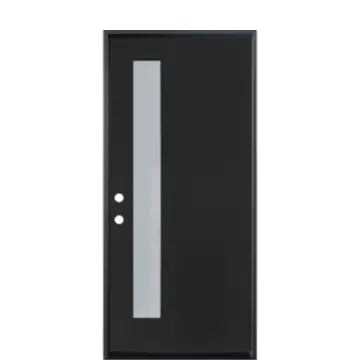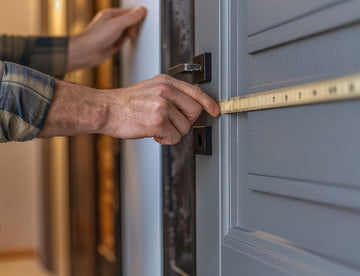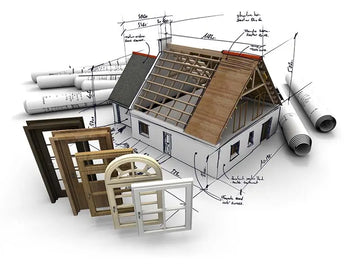
HELP WANTED
Are You a Pro?
We are seeking licensed contractors with expertise in installing interior and exterior doors to partner with AAA Doors as an outside installation pro.
Contact AAA Doors today to become one of our licensed installers.
Frequently Asked Questions
When should I replace my front door?
You should consider replacing your front door if you notice any of the following issues:
- Damaged or Warped Door: If your door has significant damage, such as cracks, dents, warping, or holes, it might be time to replace it. Not only does this impact the appearance of your home, but it could also be letting in drafts, which can increase your energy costs.
- Difficulty in Opening/Closing: If your door doesn't open or close smoothly, it may be warped or the house may have settled around the frame. This can cause gaps and drafts, and can also be a security risk.
- Drafts: If you can feel a draft even when your door is closed, it might not be sealing properly. This can cause heat loss in the winter and make your air conditioner work harder in the summer.
- Condensation between double glazing: If you notice condensation or fogging between the glass panes in your door, the seal could be broken, which reduces the door's insulating properties.
- Outdated Design: If your door looks outdated, it might not match the rest of your home's curb appeal. A new front door can dramatically improve the look of your home.
- Noise Pollution: If you're hearing more outside noise than usual, it could be because your door isn't blocking sound as effectively as it should.
- Security: Older doors, or doors with single pane glass or weak locks, can be easier for intruders to breach. If you're concerned about security, a new door might be a good idea.
- High Maintenance: If your door requires frequent repairs or refinishing, it might be more cost-effective to replace it.
- Energy Efficiency: Newer doors often have better insulating properties, which can reduce your heating and cooling costs.
- In general, a good quality front door can last several decades. But the factors above can all indicate that it's time to consider a replacement. Always consult with a professional if you're unsure.
Can I leave my door unfinished?
Yes, you can leave your door unfinished. However, there are several factors you should consider:
- Durability: An unfinished door is more susceptible to damage from environmental factors, like moisture, sunlight, and temperature changes. This could lead to warping, fading, or deterioration over time.
- Aesthetics: The unfinished look can be appealing and rustic, but keep in mind that the color and texture of the door will change over time due to exposure to the elements.
- Maintenance: An unfinished door may require more frequent cleaning and maintenance. Because it lacks a protective layer, dirt, grime, and stains can more easily penetrate the wood, leading to potential damage.
- Indoor vs. Outdoor: If the door is inside, it will be less exposed to environmental damage, but can still be affected by indoor humidity levels. For an outdoor door, the effects of weathering will be much more significant.
- So while it's possible to leave a door unfinished, it may be beneficial in terms of longevity and maintenance to finish it with paint, stain, or a clear protective sealant.
Can 6-1/2 in. jamb work for my 4-1/2 in. wall?
- Yes, a 6-1/2 inch jamb can technically work for a 4-1/2 inch wall, but it will not be a perfect fit as it would extend beyond the wall's thickness. This could result in a non-flush finish on one side and could be visually unappealing or create issues with door trim or wall finishing.
- Typically, you would select a door jamb that is the same thickness as your wall (or slightly less to account for interior drywall or exterior sheathing), so for a 4-1/2 inch wall, a 4-1/2 inch jamb would be a more suitable choice.
- However, if you already have a 6-1/2 inch jamb, it is possible to trim it down to fit your wall with the right tools and carpentry skills. This involves carefully cutting the excess material from the jamb without damaging its structure.
- In any case, it may be best to consult with a carpentry or home improvement professional to determine the best solution for your specific situation.
How do I determine my door swing?
Determining the swing of your door is a crucial step in door installation or replacement. Here's how you can do it:
- Stand on the Secure Side of the Door: The secure side is the side of the door where you would put a key into the lock. Typically, for an exterior door, this is on the outside, and for an interior door, it's usually the hallway or main room side.
- Locate the Door Hinges: The location of the hinges relative to you will help you determine the swing of your door.
- Open the Door: If the door swings away from you to the right, then it's a right-hand door swing. If it swings away from you to the left, then it's a left-hand door swing.
- If the door swings towards you, the process is similar but with an additional "reverse" label. If the hinges are on your right and the door swings towards you, it's a right-hand reverse door. If the hinges are on your left and the door swings towards you, it's a left-hand reverse door.
- Remember, the key is to stand on the secure (key) side of the door when determining the swing.
Do you offer financing?
Yes, through PayPal Credit and Affirm. PayPal Credit offers 0% financing for 6 months. Affirm loans vary between 10% and 30% APR simple interest for up to 48 months.
What is your price-match policy?
We are committed to providing the highest quality products at the best possible prices. If you find a lower advertised price on same exact doors, we will gladly match the price.
What is the difference between fiberglass and a wood door?
Fiberglass and wood are two popular materials used in door construction, each with their own unique characteristics and benefits:
Wood Doors:
- Aesthetics: Wood doors offer a classic, timeless look that many homeowners love. They can be stained or painted to enhance the natural wood grain and to match any style or color scheme.
- Insulation: Wood is a natural insulator, which can help to keep your home warmer in the winter and cooler in the summer.
- Customization: Wood doors can be customized quite easily, and are available in a variety of designs, from simple to ornate.
- Maintenance: Wood doors require regular maintenance to keep them looking their best. This might include periodic painting or staining, and sealing to protect the door from moisture and prevent warping or rotting.
- Durability: Solid wood doors are sturdy and durable, but can be susceptible to the elements, especially in humid climates or places with lots of rain.
Fiberglass Doors:
- Aesthetics: Fiberglass doors can be made to mimic the look of wood, complete with a realistic grain texture. They can also be painted or stained in a variety of colors.
- Insulation: Fiberglass doors offer excellent insulation, often surpassing wood in energy efficiency, which can help to reduce your heating and cooling costs.
- Maintenance: Fiberglass doors require less maintenance than wood. They resist denting and scratching, and aren't susceptible to rusting, rotting, or warping. They can also stand up well to harsh or fluctuating weather conditions.
- Durability: Fiberglass doors are very durable and have a long lifespan. They offer superior resistance to wear and tear, making them a good choice for high-traffic areas.
- Cost: Fiberglass doors tend to be more cost-effective than solid wood doors, and given their durability and low maintenance needs, they often represent a good investment over time.
Your choice between a fiberglass and wood door will depend on your specific needs, budget, and aesthetic preferences. Both types of doors can make an excellent choice for both interior and exterior applications.
What is the difference between solid core and hollow core interior doors?
Solid core and hollow core refer to the construction of the interior of the door. Here are the main differences between the two:
- Solid Core Doors: As the name implies, these doors are solid all the way through. They may be made entirely of solid wood, or they may have a solid composite or engineered wood core with veneer faces. Solid core doors are more soundproof, offer better insulation, and are more durable and sturdy compared to hollow core doors. However, they are also heavier, which makes them harder to install, and more expensive.
- Hollow Core Doors: These doors are essentially a frame made out of plywood or a similar material, with a hollow interior. They are lighter and easier to install, and they are usually less expensive than solid core doors. However, they provide less insulation and soundproofing, and they're also more susceptible to damage from impacts.
Your choice between solid core and hollow core doors depends on your specific needs, budget, and preferences. Solid core doors can be a good choice for areas where you want more privacy or where the door will see a lot of use, while hollow core doors can be a cost-effective choice for areas where these factors are less important.
What are the available delivery methods?
For our doors, we utilize LTL (Less-than-Truckload) shipping services with curbside delivery. Here's what that means:
- LTL (Less-than-Truckload) Shipping: This method is used for shipments that are larger than parcel or small package services, but smaller than a full truckload. It's a cost-effective way to transport large items like doors because you're only paying for the portion of the truck you're using, not the entire truck.
- Curbside Delivery: With curbside delivery, your door will be delivered to the curb of your residence. The delivery driver will not bring the door inside your house or garage. You will be responsible for moving the door from the curb to your desired location. This may require additional people or equipment depending on the size and weight of the door.
Please note that someone must be present at the time of delivery to accept the shipment and check it for any damage during transport. The delivery service will typically contact you in advance to arrange a delivery time.
How much does an iron door weigh?
The weight of an iron door can vary greatly based on its size, design, thickness of material, and whether it has glass elements.
- As a general guideline, a standard-sized (36 inches by 80 inches) single iron door can weigh between 200 and 500 pounds. Double iron doors or larger single doors can weigh even more. For example, double doors (72 inches by 80 inches) might weigh anywhere from 500 to 1000 pounds.
- Keep in mind these are estimates and the actual weight could be more or less depending on the specific door. Always check the specifications provided by the manufacturer for the most accurate information.
Due to their weight, iron doors can be challenging to handle and install. Professional installation is usually recommended for these types of doors to ensure safe and correct installation.
Should I stain or paint my door before or after installation?
Whether you should finish your door before or after installation largely depends on the type of door, the finish you're applying, and your personal preference. Here are some points to consider:
- Finishing Before Installation: Finishing a door before installation can be easier as you can lay the door flat and reach all areas without obstructions. This method allows for an even application of paint or stain, and prevents drips or pooling that can occur when finishing a vertically hung door. It also allows you to finish all six sides of the door (front, back, bottom, top, and sides), providing complete protection from moisture and warping. However, you'll need to allow ample time for the finish to dry before installation, and be careful not to damage the finish during the installation process.
- Finishing After Installation: Finishing a door after installation lets you see how the door looks in place, which can be helpful when deciding on a final color or finish. It also means you don't have to worry about damaging the finish during installation. However, painting or staining a door in place can be more challenging due to gravity affecting the finish application, and because it may be harder to reach all areas of the door—especially the top and bottom edges.
In general, it's often recommended to at least apply a primer or a first coat of finish before installation. This provides some protection to the door during installation, and allows you to seal all six sides of the door. You can then apply the final coats after installation. Always follow the finish manufacturer's instructions, and consult with a home improvement professional if you're unsure.
How do I measure my door?
Measuring your door correctly is important when ordering a new one or planning to change the existing door. Here are the steps:
- Measure the Width: Measure the width of the door from one side to the other. Take measurements at the top, middle, and bottom of the door, because not all doors are perfectly uniform. The widest measurement is the one you'll need to use.
- Measure the Height: Measure the height of the door from the top edge to the bottom edge. Like with the width, take measurements at the left, middle, and right side of the door. Use the longest measurement.
- Measure the Thickness: Measure the thickness of the door by taking the measurement from the inside edge to the outside edge.
- Measure the Door Jamb: If you're measuring for a prehung door, you'll also need to measure the door jamb. Measure from the back of the interior trim to the back of the exterior trim.
- Note: Always use a reliable tape measure for accuracy, and it may be beneficial to have another person assist to ensure the tape measure is level.
Remember to consider any irregularities or warping in the existing door, as this could impact the accuracy of your measurements. If you're unsure, a professional can help measure accurately.
How long can I store my unfinished door in the garage?
How long you can store an unfinished door in your garage depends on the conditions of the storage space and how well the door is protected. If stored properly, an unfinished door can be kept in the garage for several months without significant damage. However, it's important to consider these factors:
- Climate Control: Unfinished wood can absorb moisture from the air, which can cause warping, swelling, or shrinking. If your garage is subject to high humidity or dramatic temperature changes, it might not be the best place for long-term storage.
- Protection: The door should be covered to protect it from dust and accidental scratches or dents. However, avoid wrapping it in plastic as this can trap moisture against the wood.
- Position: Store the door flat and off the ground, if possible, to prevent warping. If you need to store it vertically, make sure it's not leaning, as this can cause the door to bend or warp over time.
- Pests: The garage should be free from pests like termites that could potentially damage the wood.
Remember that the door will need to be finished with paint, varnish, or some type of sealant to protect it once it's installed. It's generally better to finish the door shortly after purchase rather than storing it unfinished for an extended period of time. If you anticipate a long delay before installation, consult with a home improvement or woodworking professional about the best way to store the door.
What is the difference between a slab and a pre-hung door?
A slab door and a pre-hung door are two different types of doors you can purchase, each with its own advantages and considerations. Here's what distinguishes them:
- Slab Door: A slab door is simply the door itself. It doesn't come with a frame, hinges, or door hardware. It's called a "slab" because that's essentially what you're getting – a flat slab of wood, metal, or composite material. Slab doors allow for more customization since you can choose your own hardware, but they require more work to install. You'll need to cut out the hinge mortises and door handle or knob yourself. Slab doors are a good choice if you're replacing an existing door and your frame is still in good condition.
- Prehung Door: A prehung door comes with everything already assembled – the door, hinges, and the frame (also known as the door jamb). Often, it will also come with pre-drilled holes for the doorknob and latch. Prehung doors are typically easier and quicker to install, especially if you're putting a door in a new location, because you don't have to worry about precisely aligning the hinges or building a door frame. However, they're usually more expensive than slab doors due to the additional components and assembly.
The choice between a slab door and a prehung door depends largely on your specific project needs, your budget, and your comfort level with door installation.


